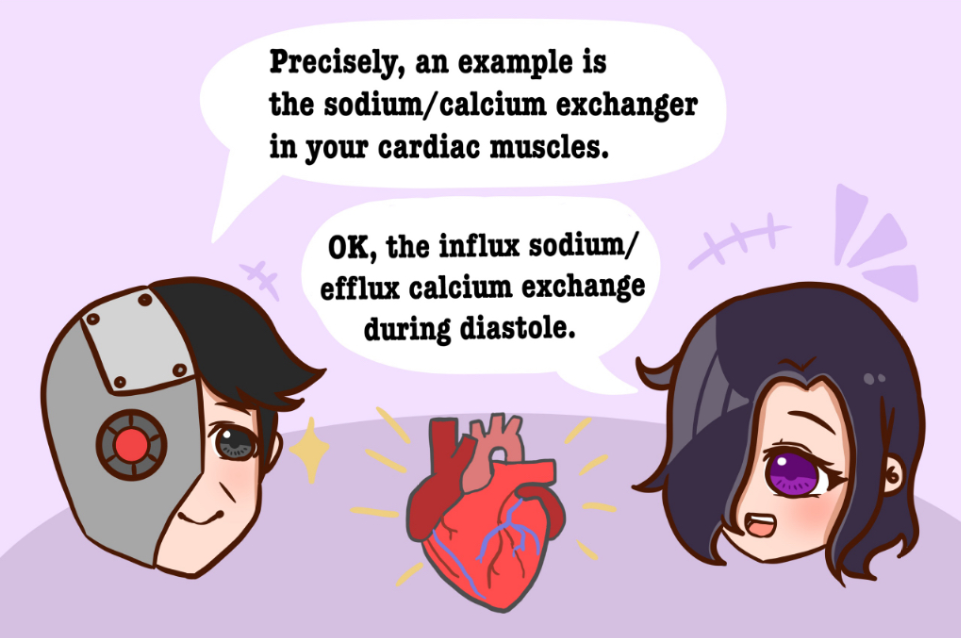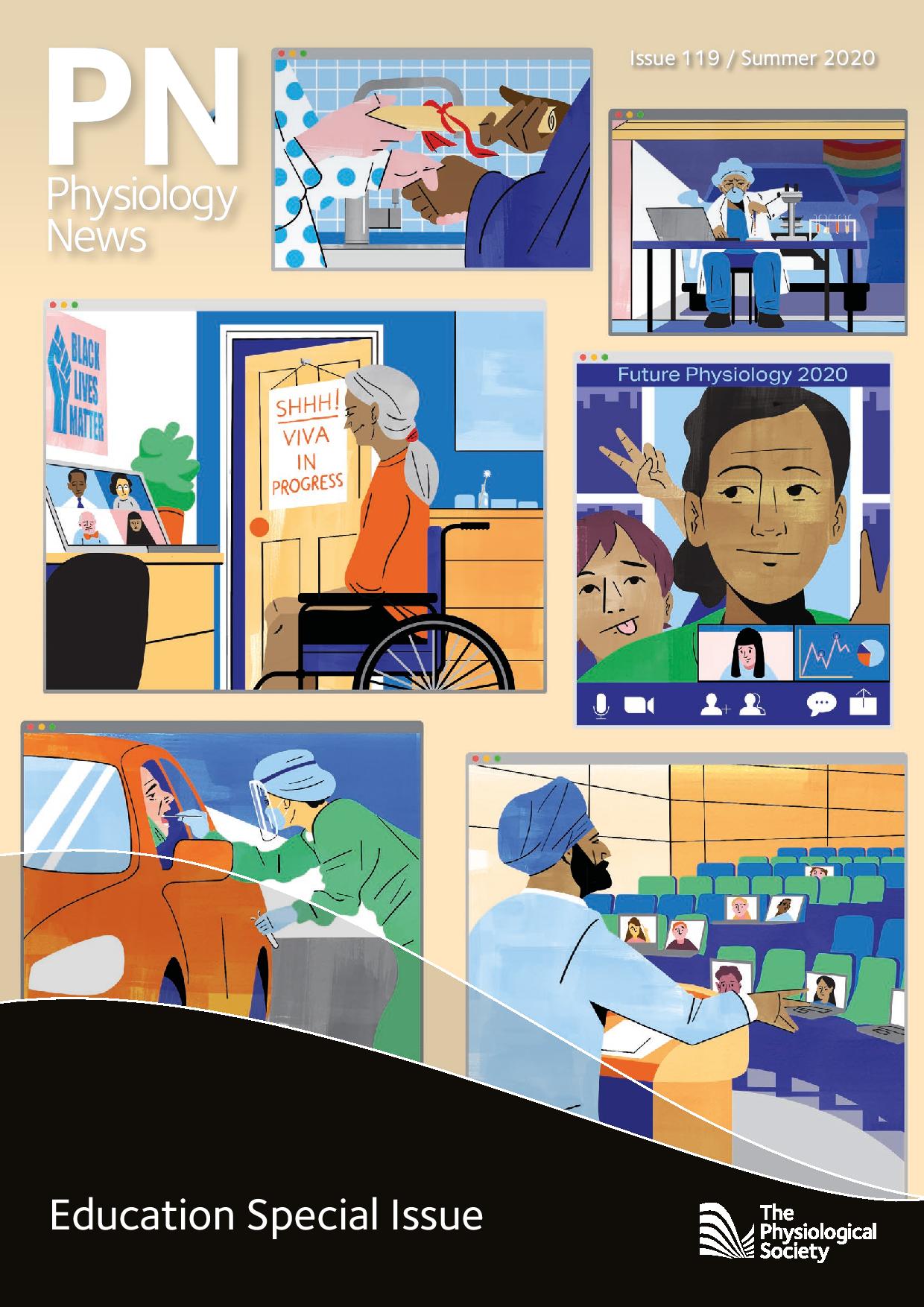
Physiology News Magazine
Homeostatic teaching
Unmasking the beauty of physiology
Features
Homeostatic teaching
Unmasking the beauty of physiology
Features
Hwee Ming Cheng, University of Malaya, Malaysia
https://doi.org/10.36866/pn.119.32
“The Teacher searched to find just the right words.” (Ecclesiastes 12:10) and I share this snapshot of a personal academic journey to encourage and inspire teachers and students of physiology. In our intellectual journey, we can uncover and discover together the revealed beauty, design and wonder of integrated physiology. Both students and teachers should never cease to learn, to think through, to write, express creatively and enjoy physiology.
The immunophysiologist
I graduated with a Joint Honors in Medical Cell Physiology and Biochemistry in 1980 and completed my PhD in Immunology 1983, both from the University of Liverpool. My PhD was on the immunobiology of human placenta (nature’s transplant) and I have memories of going each morning to the Liverpool Maternity Hospital to collect fresh placentas to prepare the syncytiotrophoblast membrane.
I started teaching physiology in 1985 at the Universiti Malaya, Kuala Lumpur, which had no existing immunology department at the time. The difficulty of resuming my placental research led me to work on natural physiologic autoantibodies to cardiolipin and other phospholipids (1).
Colleagues in my generation will appreciate those pre-KPI (key performance index) and SOP (standard operating procedure) days. I had time to read a lot, comparing different author’s perspectives on defining and describing the wisdom of physiology in the body. I had more face to face time with students. I believe we need to recover what I and my colleagues experienced during this time when the demand, for documentation of matters that are less essential in an academic sense, wasn’t as great.

I inculcated a habit of making notes of students’ responses, both from their answer scripts, small group tutorials, and personal consultations in my office. If I experienced that several of my students found a certain aspect of physiology particularly difficult, I gathered that a misconception must be common and/or a clearer teaching is needed in relation to this topic. I have continued and evolved this practice throughout my career, which I designate homeostatic teaching.
Homeostatic teaching
Over the many years of interacting with students of medicine, dentistry, pharmacy, biomedicine and nursing in the context of physiology courses, I found that it was necessary to customize the lecture contents to suit the student audience. My experience is that it is often harder to simplify physiology appropriately for the purpose of communicating it to diploma than to undergraduate students, but in both instances focus on formulating questions to probe understanding rather than factual knowledge in physiology (2).
Increasingly, the younger generation writes less . This non-writing culture is not helped by the teaching practice of fewer writing evaluations in the context of physiology courses, where much of the testing now merely consists of online single best answers. Writing focuses the mind and streamlines thinking, and how our students write to express physiology provides the teacher with a much better impression of their correct or imprecise grasp in defining physiology. Take the word ‘buffer’ as an example. The meaning or function of a urinary buffer and an extracellular fluid (ECF) buffer is different. While ECF buffers serve to maintain pH, urinary buffers do not maintain tubular fluid pH, but rather allow more excretion of total acid at the limiting urine pH of around 4.0. This exemplifies Linda Costanzo, who kindly wrote the preface to my book ‘Defining Physiology’ and said “Definitions are physiology’s best touchstone” (3).
Furthermore, homeostatic teaching involves re-teaching. We continually fine-tune and improve our lecture notes following feedback from contact times with students, in an attempt to increase the impact of our teaching.
Beautiful physiology
“A thing of beauty is a joy forever,”writes John Keats in Endymion (1818), and as teachers we know the delight when we hear the “Oh wow” moments of our students when we explain various aspects of physiology. The sense of wonder in appreciating the integrative and organizing design of multi-organ physiology promotes learning.
In respiratory physiology classes, I tell my students that carbon dioxide is not just merely a metabolic product, but also a vasodilator, an oxygen unloader (the Bohr effect), the major ventilation chemical regulator, and an essential ECF pH buffer component paired with bicarbonate. This gives them a bird’s (or drone’s) eye view of whole-body physiology. This may even be expanded to the ecological level, as the carbon dioxide from our “respiratory tree” gives life to the greenery around us.
However, with increasingly exciting details of cellular physiology, students can get overwhelmed. It is thus useful to help students see common mechanistic processes that govern different organ physiology. For example, the renal and gastrointestinal “peeing and pooing” events share common epithelial pathways to handle their luminal contents (4).
The beauty and wisdom of the body are also seen in the discernment and priority given to survival. In severe hypovolemia, the critical need to maintain volume overrides or masks normal osmoregulation, which results in a hypotonic contraction.
A recurring event during my physiology courses is that I take my students to “Kidneyland” and show them the two intrinsic renal events of tubuloglomerular (T-g) macula densa feedback and glomerulo-tubular (G-t ) balance. But I also show them that when vascular volume is depleted, these T-g and G-t responses are masked by the extrinsic renal sympathetic nerve and the renin-angiotensin aldosterone activation to restore ECF/blood volume and sodium balance. When euvolemia is achieved, then the T-g and G-t intrinsic mechanisms are unmasked and observed. This is the convoluted beauty of our kidneys (5).
Regrettably, I have noted – and this also echoed by my Malaysian and overseas colleagues – that with the introduction of the integrated curriculum with anatomy, biochemistry and pharmacology, there is an accompanying disintegration and fragmented grasp of physiology among my students. The beauty of physiology is masked.
Engaging, enjoying physiology
Teachers complain that students’ attention spans are shorter these days and they become easily hyperpolarized during class (perhaps in under 20 minutes!). It is quite true, but I have noticed that the element of surprise engages our students. To accommodate this, I have designed a number of physiology statements that appear true and ask students what they think. For example I tell them that: “Sodium concentration is controlled by aldosterone”
Most students quite quickly say it is true, and you do get their attention when you tell them otherwise. Drinking a large volume of water produces a transient hyponatremia which is homeostatically regulated by osmoregulation. The sodium concentration (not sodium balance) is under the control of antidiuretic hormone, not aldosterone.
Interestingly, this statement when used at the International Physiology Quiz (see below registered less than 50% correct responses. This common misperception of the difference between sodium balance and sodium concentration control was addressed in my paper entitled “Students lose balance over the yin-yang of sodium physiology” (6). Similar, “why what’s wrong” (www) physiology statements to engage students have been compiled and this has been a useful tool to help depolarize my students during class.
The questions unmask common misconceptions in physiology.
Apart from these physiology statements which may be used during class, I and others have written physiology lyrics to popular tunes to liven up the class. My students love the one on Starling’s law of the heart which was matched to the song ‘O my Darling’. My students homeostatically moved the lyrics to Justin Bieber’s upbeat tune (7)!
The IMSPQ global platform and bridge
The Inter-Medical School Physiology Quiz (IMSPQ) was held in 2003 in Kuala Lumpur. From a small beginning of just seven competing universities in Malaysia, the IMSPQ now draws about one hundred medical schools from over twenty countries. This year the 18th IMSPQ scheduled for August 2020 has unfortunately also been “coronated” by the COVID-19 pandemic .
In place of the 18th Quiz, we are planning an Online Physiology Comic Challenge. A sample creation is shown here, by my students Rachael Chin Kit Yi and Wong Zhu Shi, and the script by yours truly Dr XCheng (Fig 1).
The immense interest in the IMSPQ has catalysed National Physiology Quizzes in eleven other countries starting withSri Lanka in 2013. Since then annual quizzes have blossomed in China (2014), Japan (2015), Indonesia, Mongolia, Philippines, Myanmar (all in 2017), Australia, Romania (2018), Spain, and India (2019). Just this February 2020, the All-Pakistan quiz was held in Lahore.
Since the 12th IMSPQ in 2014, we have added a Refresher course for all accompanying lecturers of the student competing teams. These teaching inputs were given by accomplished physiology educators who included Richard Klabunde, Kim Barrett, Susan Barman, Walter Boron, Susan Wray, David Eisner and Dee Silverthorn. Robert Carroll was to be the invited Refresher speaker at the ‘coronated’ 18th IMSPQ.
Susan Barman, a former President of the American Physiology Society (APS) was so enthused with the IMSPQ that she initiated the first regional quiz in Michigan APS chapter in 2017. Susan is actively encouraging other APS chapters to use the quiz platform to promote physiology interest.
The IMSPQ has provided a unique, invaluable global sample of students, all responding to the same set of Physiology questions. The analysis of the IMSPQ data has given us insights and unmasked common misconceptions in learning Physiology (8).
Land of Academia
I continue on my physiologic journey, happily locked down with my students due to te COVID-19 pandemic, re-teaching and researching. I end here with the same quote in my Inaugural lecture in 2011 (9).
“All their life in Narnia had been the cover and the title page: now at last they were beginning Chapter One of the Great Story which no one on earth has read: which goes on forever: in which every chapter is better than the one before” (C.S. Lewis: The Last Battle, 1956)
Hwee Ming Cheng (b. 1958) has a PhD in immunology from the University of Liverpool, UK (1983), and is Professor of Physiology at the University of Malaya, Kuala Lumpur, Malaysia. He is a renowned physiology teacher, and has written several textbooks on physiology teaching. Furthermore, he founded the Inter-Medical School Physiology Quiz in 2003, which included students from 20 countries in 2019.
References
- Cheng HM (1994). Immunophysiology of Antiphospholipid Autoantibodies. RG Landes Co.
- Cheng HM (2015). Physiology Question-Based Learning. Cardio, Respiratory and Renal Systems. Springer
- Cheng HM, Jusof F (2018). Defining Physiology: Principles, Themes , Concepts. Cardiovascular, Respiratory and Renal Physiology. Springer
- Cheng HM, Hoe SZ (2019). To pee and to poo : cross-organ principles and mechanisms in renal and gastrointestinal physiology. BLDE Univ J Health Sci 4: 22 – 27.
- Cheng HM, Hoe SZ (2016). Students’ convoluted trouble with renal autoregulation: a teaching note for students and physiology educators. BLDE Univ J Health Sci 1: 25-27.
- Cheng HM, Hoe SZ (2018) Students lose balance over the yin-yang of sodium physiology. BLDE Univ J Health Sci 3: 54-57.
- ‘O My Starling’ to Justin Bieber’s Baby https://www.youtube.com/watch?v=aqmkJXYh9EU
- Cheng HM, Durairajanayagam D ( 2012) Misconceptions highlighted among medical students in the annual international intermedical school physiology quiz. Adv Physiol Edu 36: 229 – 232
- Cheng HM : A Physiologic Journey. Inaugural Lecture Universiti Malaya 2011. https://jummec.um.edu.my/article/view/4683/2476
